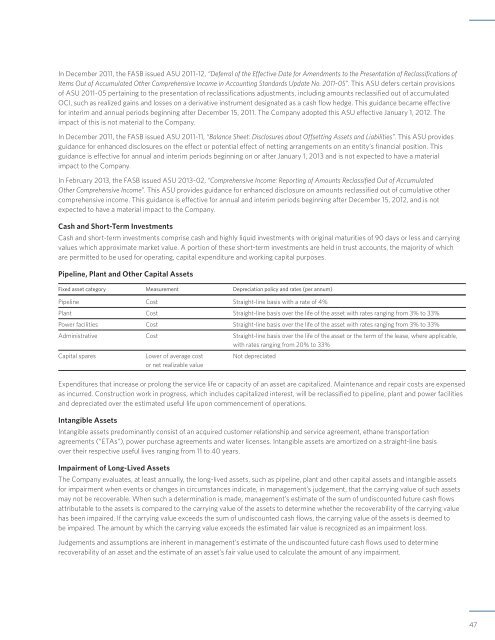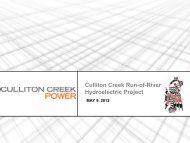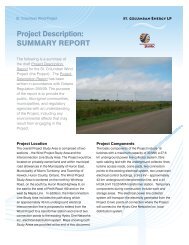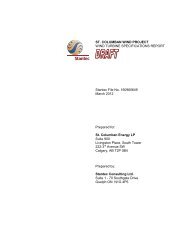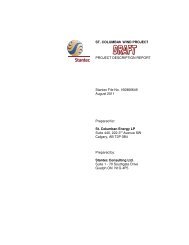Financial Report - Veresen Inc.
Financial Report - Veresen Inc.
Financial Report - Veresen Inc.
You also want an ePaper? Increase the reach of your titles
YUMPU automatically turns print PDFs into web optimized ePapers that Google loves.
In December 2011, the FASB issued ASU 2011-12, “Deferral of the Effective Date for Amendments to the Presentation of Reclassifications of<br />
Items Out of Accumulated Other Comprehensive <strong>Inc</strong>ome in Accounting Standards Update No. 2011-05”. This ASU defers certain provisions<br />
of ASU 2011-05 pertaining to the presentation of reclassifications adjustments, including amounts reclassified out of accumulated<br />
OCI, such as realized gains and losses on a derivative instrument designated as a cash flow hedge. This guidance became effective<br />
for interim and annual periods beginning after December 15, 2011. The Company adopted this ASU effective January 1, 2012. The<br />
impact of this is not material to the Company.<br />
In December 2011, the FASB issued ASU 2011-11, “Balance Sheet: Disclosures about Offsetting Assets and Liabilities”. This ASU provides<br />
guidance for enhanced disclosures on the effect or potential effect of netting arrangements on an entity’s financial position. This<br />
guidance is effective for annual and interim periods beginning on or after January 1, 2013 and is not expected to have a material<br />
impact to the Company.<br />
In February 2013, the FASB issued ASU 2013-02, “Comprehensive <strong>Inc</strong>ome: <strong>Report</strong>ing of Amounts Reclassified Out of Accumulated<br />
Other Comprehensive <strong>Inc</strong>ome”. This ASU provides guidance for enhanced disclosure on amounts reclassified out of cumulative other<br />
comprehensive income. This guidance is effective for annual and interim periods beginning after December 15, 2012, and is not<br />
expected to have a material impact to the Company.<br />
Cash and Short-Term Investments<br />
Cash and short-term investments comprise cash and highly liquid investments with original maturities of 90 days or less and carrying<br />
values which approximate market value. A portion of these short-term investments are held in trust accounts, the majority of which<br />
are permitted to be used for operating, capital expenditure and working capital purposes.<br />
Pipeline, Plant and Other Capital Assets<br />
Fixed asset category Measurement Depreciation policy and rates (per annum)<br />
Pipeline Cost Straight-line basis with a rate of 4%<br />
Plant Cost Straight-line basis over the life of the asset with rates ranging from 3% to 33%<br />
Power facilities Cost Straight-line basis over the life of the asset with rates ranging from 3% to 33%<br />
Administrative Cost Straight-line basis over the life of the asset or the term of the lease, where applicable,<br />
with rates ranging from 20% to 33%<br />
Capital spares Lower of average cost Not depreciated<br />
or net realizable value<br />
Expenditures that increase or prolong the service life or capacity of an asset are capitalized. Maintenance and repair costs are expensed<br />
as incurred. Construction work in progress, which includes capitalized interest, will be reclassified to pipeline, plant and power facilities<br />
and depreciated over the estimated useful life upon commencement of operations.<br />
Intangible Assets<br />
Intangible assets predominantly consist of an acquired customer relationship and service agreement, ethane transportation<br />
agreements (“ETAs”), power purchase agreements and water licenses. Intangible assets are amortized on a straight-line basis<br />
over their respective useful lives ranging from 11 to 40 years.<br />
Impairment of Long-Lived Assets<br />
The Company evaluates, at least annually, the long-lived assets, such as pipeline, plant and other capital assets and intangible assets<br />
for impairment when events or changes in circumstances indicate, in management’s judgement, that the carrying value of such assets<br />
may not be recoverable. When such a determination is made, management’s estimate of the sum of undiscounted future cash flows<br />
attributable to the assets is compared to the carrying value of the assets to determine whether the recoverability of the carrying value<br />
has been impaired. If the carrying value exceeds the sum of undiscounted cash flows, the carrying value of the assets is deemed to<br />
be impaired. The amount by which the carrying value exceeds the estimated fair value is recognized as an impairment loss.<br />
Judgements and assumptions are inherent in management’s estimate of the undiscounted future cash flows used to determine<br />
recoverability of an asset and the estimate of an asset’s fair value used to calculate the amount of any impairment.<br />
47


